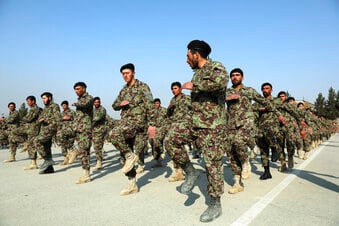One of the major mistakes of the war in Afghanistan and the simultaneous U.S. effort to rebuild it as a democratic country may have been an over-reliance on the military, the Special Inspector General for Afghan Reconstruction told lawmakers on Wednesday.
Though the State Department and the U.S. Agency for International Development were also on the ground throughout that 20-year period, the Defense Department’s budget and capacity for risk-taking may have edged out any purely diplomatic or humanitarian efforts.
“DoD didn’t crowd them out for nefarious reasons,” John Sopko told Rep. Joaquin Castro, D-Texas, when asked about the influence the military wielded over the Afghanistan effort. “It was just, I think ,the reality of the situation.”
DoD’s funding “overwhelmed” that of State and USAID, he said. They also had the advantage of being able to penetrate and navigate unsafe areas.
“The ultimate thing is, Congress, the American people and the administration ― whoever’s in the White House, Democrat or Republican ―has to realize that diplomacy is never going to be totally risk-free,” Sopko said. “We expect, and we understand, when DoD takes calculated risks. There has been a tendency, and I saw this over time in Afghanistan, a fear among State Department officials and AID officials to take risk. As a result, people didn’t leave the compounds. People don’t go over the wire and do work they need to do.”
The military also just had more people.
“You talk about some of the meetings and organizations that were set up, in which there was supposed to be equal membership from State, AID and DoD,” Sopko added. “And maybe there’d be one person from AID, and one person from State, and 20 people from DoD. That is a particular problem.”
So many of the projects, from construction to building ties with local leadership, fell to the military.
“You can’t do development or reconstruction in months, or even half a year, or a year ―it takes time,” Sopko said. “And what happened is, DoD was given the reins to do a lot of the development and didn’t know how to do it, didn’t have the capability, didn’t have the expertise, and that’s particularly a problem.”
RELATED

It comes down to funding, he said, and the military never had an issue securing it.
“We would tend to view more bodies in State and AID as a waste of money, but we don’t, if we’re talking about the Defense Department, and I think [we have to] get over that and realize State and AID have important missions,” he added. “They have to be fully funded.”
Reliance on the military ― with its funding, personnel and logistics capabilities ― will likely one of the main lessons learned from Afghanistan.
“There’s an easy tendency to look at using the military, people in uniform, to resolve an issue, because you can give it direct orders, it has a lot of logistical capacity, transportation capacity,” retired Army Gen. Stanley McChrystal, who commanded troops in Afghanistan in 2010, told Military Times in a September interview. “So actually, using people in uniform to do a wide range of things is simpler than using a whole-of-government approach.”
But it’s the wrong approach, he added. Not for the any government effort, but not for the military’s readiness, either.
“They may be able to help, but they’re very rarely an entire fix,” McChrystal said. “The other problem that people have talked about is, if you use one muscle all the time, the other muscles atrophy, and you don’t get as much capacity in the Department of State, or in other parts of the government, as you really need. And so over time, you find yourself weaker, which makes you want to go back to that very strong muscle in the moment of an emergency, which just makes the problem extend itself.”
Meghann Myers is the Pentagon bureau chief at Military Times. She covers operations, policy, personnel, leadership and other issues affecting service members.




